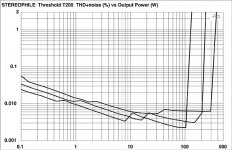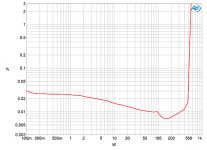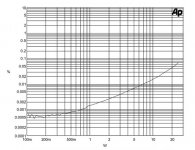Check out this one...
Jeff Rowland LM3886 Amplifiers
What is interesting is that this amp doesn't comply with the guidelines set out in the datasheet or use any of the suggestions made in the first post of this thread.
N
What we are dealing with here is the chip-amps and how to make the best of and with them.
I forgot a important thing,
1. decoupling: 1000uf per rail is more than enough for the amp's PCB, just add a 0.1uf X7R (or film cap) as close to the IC as possible.
2. If you want the lowest crosstalk and best immunity from hum in a stereo amp, go for a dual mono setup with a separate power transformer for each chipamp.
Brother, its not difficult to create a amp with the 3886 which sounds better than 90% of the stuff out there and which will impress everyone who listens to it. The 3886 has very high PSRR, CMRR, low input noise and, low IMD that it will tolerate considerable leniency with regard to circuit design and still sound great. So long as you are careful with grounding and supply decoupling you can be sure to obtain a high quality amp which will impress most people.
For example: have a look at Kimura san's gaincard which started this craze, it had only 9 parts per channel, the circuit board looks terrible, the power supply had no decoupling with it being done by the 1000uf caps on the amp board and it had long power supply leads which lead to the amp being starved for power at high levels, and yet it sounded and measured great and received rave reviews at stereophille.
It's a misconception to say that i hate chipamp's, I have a self designed dual mono lm3886 setup, and it sounds great. I cannot hear any hiss even with my ear directly next to the tweeter. The lm3886 is a impressive chip provided it is operated strictly within its specifications and its not allowed to activate its protections circuits. I also have the benchmark AHB2 which is probably the cleanest and quietest amplifier in the world, but i can honestly say that I would not be able to tell the difference between the AHB2 and a good lm3886 implementation in ABX testing.
What is interesting is that this amp doesn't comply with the guidelines set out in the datasheet or use any of the suggestions made in the first post of this thread.
Yes, and still his design manages a impressive THD+N of <0.008 which isn't far from the less than <0.004% THD+N (20hz to 1K) which the NatSemi engineers were able to get for similar designs as described in the overture series high power solutions guide.
JEFF ROWLAND Model 10 Owner's Manual (Page 15 of 18)
Still believe its class b ?
Douglas Self states that "My definition of Class-B is that
unique amount of bias voltage which causes the conduction of the two output devices to overlap with the greatest smoothness and so generate the minimum possible amount of crossover distortion."
The LM3886 has a quasi complimentary output stage so it fits in with Douglas Self's above definition of class B. Its quiescent current is around 50ma which favours class B operation.
We can ask the experts about this, as I confess that I have not being to school. i crushed rocks in the quarry for many a year and had to teach myself to read and then study electronics theory.
Last edited:
> Still believe its class b ?
Please define exactly.
The textbook has Class B conducting *exactly* 180 degrees.
There are NO true class B audio amps (and no radio amps I am aware of). It could easily be argued that exact class B is not possible with real devices.
I agree with the quarry man, also D. Self. Any not-terrible audio amp will be biased-up the small amount needed to ensure more-or-less smooth crossover. Conduction is greater than 180 degrees. The most notorious exceptions run Zero bias, which causes a 0.5V glitch. (See LM324 at non-trivial current.) This means conduction is -less- than 180 degrees, which is book-defined as class C.
Please define exactly.
The textbook has Class B conducting *exactly* 180 degrees.
There are NO true class B audio amps (and no radio amps I am aware of). It could easily be argued that exact class B is not possible with real devices.
I agree with the quarry man, also D. Self. Any not-terrible audio amp will be biased-up the small amount needed to ensure more-or-less smooth crossover. Conduction is greater than 180 degrees. The most notorious exceptions run Zero bias, which causes a 0.5V glitch. (See LM324 at non-trivial current.) This means conduction is -less- than 180 degrees, which is book-defined as class C.
How about McIntosh unity coupled class B ?Wrong, all wrong...that's class ab amp.
No input signal, no current, is class b. Period.
There is plenty of class ab amps with less than 50 mA.
Please realize that the distortion parameter 0.0003% is meaningless, because it is taken from full power just before clipping. At lower levels, at which we actually listen, it is much higher and steadily increasing towards zero.
Opposite to single ended class a amp, which may have high distortion at full power, but the distortion steadily decreases towards zero.
Hence big difference in sound quality.
Hum, not really. The noise part of THD+N increases as power goes down, not the THD part. See Tom's measurements:
- for the MOD86: thd @1W: -125dB, thd @40W: -121dB
- for the lm3886DR: thd @1W : 0.0017 %, thd @40W: 0.0016 %
When it comes to noise, yes, below certain level it dominates...I am not disputing that.
I was talking in theoretical concept. When you look at distortion plot of typical class ab amp, it will typically have lowest distortion right around max power. Again, I am saying it in general, not any particular amp.
So please understand that. No need to ask 'what about mcintosh'...
I was talking in theoretical concept. When you look at distortion plot of typical class ab amp, it will typically have lowest distortion right around max power. Again, I am saying it in general, not any particular amp.
So please understand that. No need to ask 'what about mcintosh'...
Wrong, all wrong...that's class ab amp.
No input signal, no current, is class b.
Class B is exactly 180 degree conduction. The classes are ideal constructs. Any division based on idle current is doomed to misunderstanding.
Class B is exactly 180 degree conduction. The classes are ideal constructs. Any division based on idle current is doomed to misunderstanding.
In practice class b is a little less than 180 degrees.
The two transistors go into a crossover phase where neither is on.
This is the time it takes the input signal to go from one half cycle to the next as both transistors are off.
- Status
- This old topic is closed. If you want to reopen this topic, contact a moderator using the "Report Post" button.
- Home
- Amplifiers
- Chip Amps
- LM3886 (and other chipamps too)


